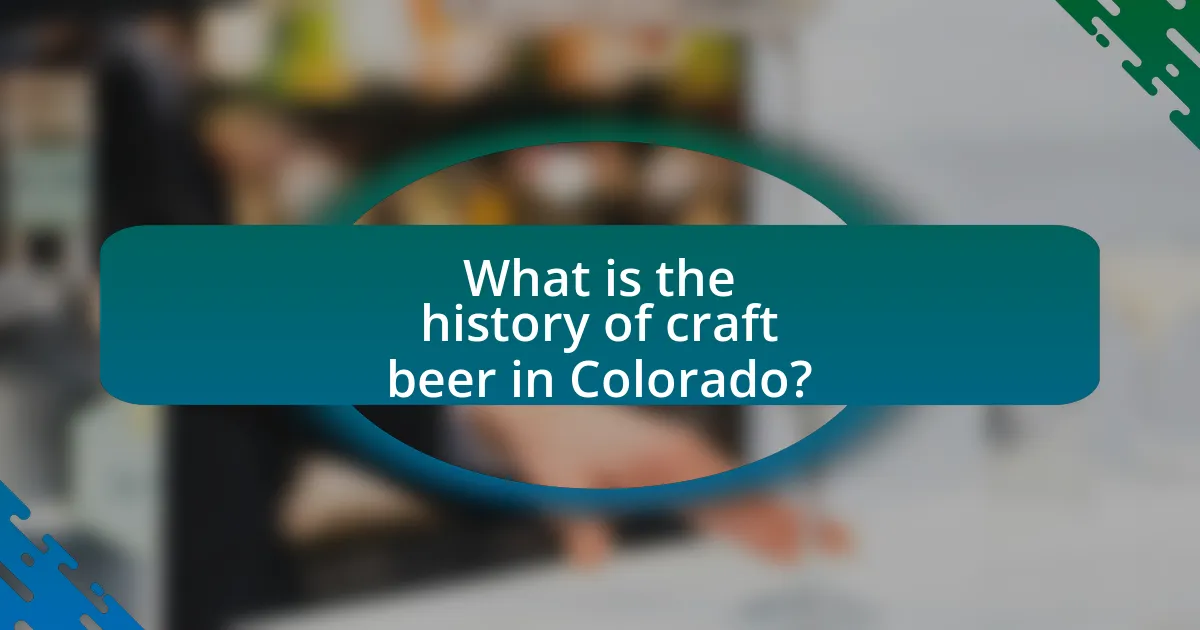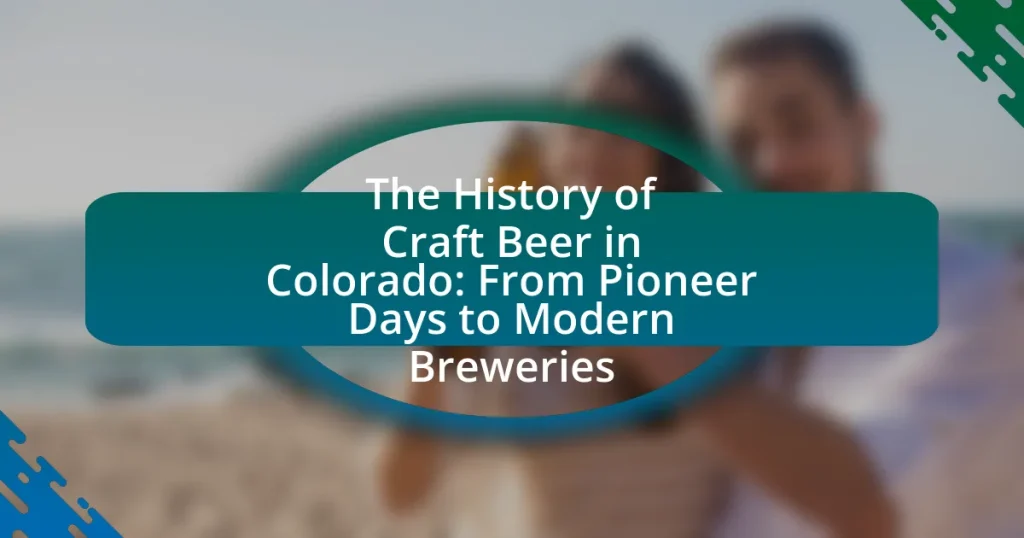The article examines the history of craft beer in Colorado, tracing its origins from the late 1970s with the establishment of Boulder Beer Company, the state’s first craft brewery, to the current landscape featuring over 400 breweries as of 2023. It highlights key events that sparked the craft beer movement, including the legalization of homebrewing and significant legislative changes that supported small breweries. The article also discusses the cultural factors that contributed to the rise of craft beer, the challenges faced by breweries, and the innovations in brewing techniques that have emerged over the decades. Additionally, it addresses the economic impact of craft beer on Colorado’s local economy and the trends shaping its future, including sustainability and technology in brewing practices.

What is the history of craft beer in Colorado?
The history of craft beer in Colorado began in the late 1970s when the state saw the emergence of small, independent breweries. The first craft brewery, Boulder Beer Company, was established in 1979, marking the start of a significant movement in the state. By the 1990s, Colorado became a hub for craft brewing, with the establishment of notable breweries such as New Belgium Brewing in 1991 and Odell Brewing Company in 1996. As of 2023, Colorado boasts over 400 craft breweries, making it one of the leading states in the craft beer industry, contributing significantly to the local economy and culture.
How did the craft beer movement begin in Colorado?
The craft beer movement in Colorado began in the late 1970s when homebrewing became legal in the state, leading to a surge in small, independent breweries. The first modern craft brewery, Boulder Beer Company, was established in 1979, setting a precedent for others. By the mid-1980s, Colorado had over 20 breweries, fueled by a growing interest in diverse beer styles and local ingredients. This early adoption of craft brewing laid the foundation for Colorado to become a leading state in the craft beer industry, with over 400 breweries by 2023, reflecting its strong culture of innovation and community support.
What were the key events that sparked the craft beer revolution?
The key events that sparked the craft beer revolution include the legalization of homebrewing in the United States in 1978, which allowed individuals to experiment with brewing techniques and flavors. This was followed by the establishment of the first modern craft brewery, New Albion Brewing Company, in 1976, which inspired many others to enter the market. The 1980s saw the rise of microbreweries, with notable examples like Sierra Nevada Brewing Co. and Boston Beer Company, which introduced innovative styles and quality standards. Additionally, the American Homebrewers Association played a crucial role in promoting craft beer culture and education. These events collectively contributed to the growth and popularity of craft beer, particularly in regions like Colorado, where a vibrant brewing community emerged.
Who were the pioneering brewers in Colorado?
The pioneering brewers in Colorado were Adolph Coors, who founded the Coors Brewery in 1873, and the Denver-based Tivoli Brewing Company, established in 1859. Adolph Coors played a significant role in shaping the state’s brewing industry, while Tivoli Brewing Company is recognized as one of the first commercial breweries in Colorado, contributing to the early craft beer movement. These breweries laid the foundation for Colorado’s rich brewing heritage, which has evolved into a vibrant craft beer scene today.
What role did legislation play in the development of craft beer?
Legislation significantly influenced the development of craft beer by establishing regulations that allowed small breweries to operate legally and thrive. The repeal of Prohibition in 1933 marked a pivotal moment, as it enabled the legal production of beer, including craft varieties. Subsequent legislation, such as the Small Business Job Protection Act of 1996, further facilitated growth by reducing federal excise taxes for small brewers, which encouraged the establishment of new craft breweries. Additionally, state-level laws, including those in Colorado, have supported craft beer through favorable licensing processes and the promotion of local brewing, contributing to a vibrant craft beer culture.
How did Prohibition impact Colorado’s brewing industry?
Prohibition severely impacted Colorado’s brewing industry by forcing the closure of many breweries and leading to a significant decline in beer production. Before Prohibition, Colorado had a thriving brewing scene, with over 50 breweries operating in the state. However, the 18th Amendment, enacted in 1920, made the production and sale of alcoholic beverages illegal, resulting in the shutdown of these establishments. By 1933, when Prohibition was repealed, only a handful of breweries had survived, drastically altering the landscape of Colorado’s brewing industry. This period of prohibition not only diminished the number of breweries but also stunted the growth of craft beer culture in the state for years to come.
What laws facilitated the growth of craft breweries in the late 20th century?
The laws that facilitated the growth of craft breweries in the late 20th century include the 1978 legalization of homebrewing and the 1983 introduction of the Small Business Tax Incentive Act. The legalization of homebrewing allowed individuals to experiment with brewing, leading to increased interest and knowledge in craft beer. The Small Business Tax Incentive Act provided financial benefits to small breweries, making it easier for them to start and operate. These legislative changes contributed to a significant rise in the number of craft breweries, with the number growing from fewer than 50 in 1980 to over 1,500 by the late 1990s.
What cultural factors contributed to the rise of craft beer in Colorado?
The rise of craft beer in Colorado was significantly influenced by a culture of outdoor recreation and community engagement. The state’s abundant natural resources, including water and agricultural products, fostered a local brewing scene that emphasized quality and innovation. Additionally, the craft beer movement in Colorado was supported by a strong sense of local pride and a desire for unique, locally-produced products, which led to the establishment of numerous microbreweries and brewpubs. By 2020, Colorado had over 400 craft breweries, reflecting the state’s commitment to craft beer as part of its cultural identity.
How did the local community support craft breweries?
The local community supported craft breweries by actively participating in their growth through patronage, events, and advocacy. Community members frequented local breweries, contributing to their financial stability and encouraging the development of unique beer offerings. Additionally, local events such as beer festivals and brewery tours fostered a sense of community and showcased local products, further enhancing visibility and support for these establishments. Furthermore, local governments often provided favorable regulations and support initiatives, recognizing the economic benefits craft breweries brought to the area. This collaborative relationship has been crucial in establishing a vibrant craft beer culture in Colorado.
What influence did outdoor activities have on craft beer popularity?
Outdoor activities significantly boosted craft beer popularity by creating social environments where consumers could enjoy local brews. In Colorado, the state’s abundant outdoor recreational opportunities, such as hiking, skiing, and biking, fostered a culture of gathering in breweries and beer gardens after outdoor adventures. This trend is supported by the fact that craft breweries often market themselves as community hubs, aligning their branding with outdoor lifestyles, which resonates with the active population. Additionally, events like beer festivals and outdoor concerts further integrate craft beer into the outdoor experience, enhancing its visibility and appeal.

How did craft beer evolve in Colorado over the decades?
Craft beer in Colorado evolved significantly from the 1970s to the present, transitioning from a few small breweries to a thriving industry with over 400 craft breweries by 2023. In the late 1970s, the craft beer movement began with the establishment of the Boulder Beer Company in 1979, marking the state’s first modern craft brewery. The 1990s saw a surge in craft breweries, driven by the rise of microbreweries and brewpubs, with notable examples like New Belgium Brewing founded in 1991. By the 2000s, Colorado became a leader in the craft beer scene, hosting the Great American Beer Festival annually, which further promoted local breweries. The state’s favorable brewing laws and culture of innovation contributed to this growth, making Colorado a hub for craft beer enthusiasts and entrepreneurs.
What were the major milestones in Colorado’s craft beer history?
The major milestones in Colorado’s craft beer history include the establishment of the first craft brewery, Boulder Beer Company, in 1979, which marked the beginning of the craft beer movement in the state. In 1988, the Colorado Brewers Guild was formed to support local breweries, further promoting craft beer culture. The 1990s saw significant growth, with the number of breweries in Colorado increasing from 10 to over 100 by the end of the decade. In 2011, Colorado hosted the Great American Beer Festival, solidifying its reputation as a craft beer hub. By 2023, Colorado had over 400 breweries, making it one of the leading states in craft beer production in the United States.
How did the number of breweries change from the 1980s to the present?
The number of breweries in Colorado has dramatically increased from the 1980s to the present. In the 1980s, Colorado had only a handful of breweries, with the first craft brewery, Boulder Beer Company, opening in 1979. As of 2023, Colorado boasts over 400 breweries, reflecting a significant growth in the craft beer industry. This expansion is supported by the rise in consumer demand for craft beer and favorable legislation that has encouraged the establishment of new breweries.
What innovations in brewing techniques emerged in Colorado?
Innovations in brewing techniques that emerged in Colorado include the use of local ingredients, such as Colorado-grown hops and grains, which enhance the flavor profiles of craft beers. Additionally, the introduction of small-batch brewing and experimental fermentation methods, including barrel-aging and sour beer production, have become prominent in the state’s craft beer scene. These techniques have been supported by the establishment of the Colorado Brewers Guild, which promotes collaboration and innovation among local breweries, leading to a diverse range of beer styles and flavors unique to the region.
How did craft beer festivals and events shape the industry?
Craft beer festivals and events significantly shaped the industry by providing a platform for breweries to showcase their products, foster community engagement, and promote craft beer culture. These gatherings, such as the Great American Beer Festival, which began in 1982, have facilitated networking among brewers, leading to collaborations and innovation in brewing techniques. Additionally, they have educated consumers about craft beer, increasing demand and supporting the growth of local breweries. The economic impact is evident, as craft beer sales in the U.S. reached over $22 billion in 2020, largely driven by the visibility and popularity generated through these events.
What are the most significant craft beer festivals in Colorado?
The most significant craft beer festivals in Colorado include the Great American Beer Festival, held annually in Denver, which is one of the largest beer festivals in the United States, showcasing thousands of beers from hundreds of breweries. Another notable event is the Colorado Brewers’ Festival in Fort Collins, celebrating local craft breweries with tastings and live music. Additionally, the Denver Beer Fest, coinciding with the Great American Beer Festival, features various events across the city, highlighting the craft beer culture. These festivals collectively attract thousands of attendees and significantly contribute to Colorado’s reputation as a craft beer hub.
How do these events promote local breweries and culture?
Events promote local breweries and culture by providing a platform for community engagement and showcasing regional craft beer. These gatherings often feature local breweries, allowing them to present their unique offerings and connect directly with consumers. For instance, festivals like the Great American Beer Festival highlight Colorado’s brewing heritage, attracting thousands of attendees and generating significant economic impact, estimated at over $20 million annually for the local economy. Additionally, these events foster a sense of community pride and cultural identity, as they celebrate local ingredients and brewing traditions, reinforcing the importance of craft beer in Colorado’s social fabric.
What challenges have Colorado craft breweries faced?
Colorado craft breweries have faced several significant challenges, including regulatory hurdles, competition, and market saturation. Regulatory hurdles often involve complex licensing processes and compliance with state and federal alcohol laws, which can be time-consuming and costly for new breweries. Additionally, the craft beer market in Colorado has become increasingly competitive, with over 400 breweries operating in the state as of 2023, leading to market saturation that makes it difficult for new entrants to gain a foothold. Furthermore, economic factors such as rising ingredient costs and supply chain disruptions have also impacted profitability and operational sustainability for these breweries.
How has competition affected small breweries in Colorado?
Competition has significantly impacted small breweries in Colorado by driving innovation and improving product quality. As the craft beer market has expanded, small breweries have had to differentiate themselves through unique flavors and brewing techniques to attract consumers. This competitive landscape has led to an increase in collaboration among breweries, fostering a community that shares resources and knowledge. According to the Colorado Brewers Guild, the number of craft breweries in Colorado grew from 92 in 2011 to over 400 by 2021, illustrating the intense competition that has emerged. This growth has also resulted in a more diverse beer selection for consumers, ultimately benefiting the local economy and enhancing the state’s reputation as a craft beer destination.
What economic factors have influenced the craft beer market?
The craft beer market has been significantly influenced by economic factors such as consumer spending trends, the growth of disposable income, and the increasing demand for locally sourced products. As disposable income has risen, consumers have shown a willingness to spend more on premium products, including craft beer, which often comes at a higher price point than mass-produced alternatives. Additionally, the trend towards supporting local businesses has driven demand for craft breweries, as consumers prefer to purchase products that contribute to their local economies. According to the Brewers Association, the craft beer segment accounted for 23.1% of the overall beer market by volume in 2020, reflecting the economic shift towards artisanal and locally produced goods.

What is the current landscape of craft beer in Colorado?
The current landscape of craft beer in Colorado is characterized by a vibrant and diverse brewing scene, with over 400 breweries operating statewide as of 2023. This growth reflects Colorado’s status as a leader in the craft beer movement, with cities like Denver and Boulder serving as hubs for innovation and quality. The state’s breweries produce a wide range of styles, from traditional ales to experimental brews, catering to a growing consumer demand for unique flavors and local products. Additionally, Colorado craft breweries contribute significantly to the economy, generating over $3 billion in economic impact and employing thousands of residents. This robust environment is supported by a strong community of beer enthusiasts and events like the Great American Beer Festival, which showcases the state’s brewing excellence.
How many craft breweries are currently operating in Colorado?
As of 2023, there are approximately 400 craft breweries operating in Colorado. This number reflects the state’s vibrant craft beer scene, which has grown significantly since the early 1980s when the craft brewing movement began to take shape. Colorado is recognized for its diverse range of breweries, contributing to its reputation as a leading craft beer destination in the United States.
What types of craft beer styles are most popular among consumers?
The most popular craft beer styles among consumers include India Pale Ales (IPAs), stouts, and pale ales. IPAs have gained significant traction due to their hoppy flavor profiles and variety, with the Brewers Association reporting that they account for over 25% of craft beer sales in the United States. Stouts, known for their rich, dark flavors, and pale ales, which offer a balanced taste, also remain favorites among craft beer enthusiasts. These styles reflect consumer preferences for bold flavors and diverse brewing techniques, contributing to the ongoing growth of the craft beer industry.
How do Colorado breweries differentiate themselves in a crowded market?
Colorado breweries differentiate themselves in a crowded market through unique branding, innovative brewing techniques, and local ingredient sourcing. Many breweries emphasize their distinct identities by creating signature beers that reflect local culture and flavors, such as using Colorado-grown hops and grains. For instance, breweries like New Belgium and Odell Brewing have established strong brand identities tied to sustainability and community involvement, which resonate with consumers. Additionally, the state’s diverse craft beer scene encourages experimentation with styles and flavors, allowing breweries to stand out by offering limited-edition brews or seasonal specialties. This strategic focus on local engagement and innovation has contributed to Colorado’s reputation as a craft beer hub, with over 400 breweries operating in the state as of 2023.
What trends are shaping the future of craft beer in Colorado?
The future of craft beer in Colorado is being shaped by trends such as increased emphasis on sustainability, innovation in brewing techniques, and the rise of local ingredients. Sustainability practices are becoming essential as breweries adopt eco-friendly methods, with 70% of Colorado breweries implementing some form of sustainable practice, according to the Colorado Brewers Guild. Innovation is evident in the experimentation with unique flavors and styles, including the use of non-traditional ingredients like fruits and spices, which cater to evolving consumer tastes. Additionally, the focus on sourcing local ingredients supports the state’s agricultural economy and enhances the freshness of the beer, with many breweries forming partnerships with local farms. These trends indicate a dynamic future for Colorado’s craft beer industry, driven by consumer demand for quality, sustainability, and local authenticity.
How is sustainability impacting brewing practices in Colorado?
Sustainability is significantly impacting brewing practices in Colorado by encouraging breweries to adopt eco-friendly methods and reduce their carbon footprint. Many Colorado breweries are implementing water conservation techniques, utilizing renewable energy sources, and sourcing local ingredients to minimize environmental impact. For instance, breweries like New Belgium Brewing have invested in solar energy and waste reduction programs, achieving a 99% diversion rate from landfills. This shift towards sustainable practices not only enhances the environmental responsibility of breweries but also appeals to a growing consumer base that prioritizes sustainability in their purchasing decisions.
What role does technology play in modern brewing processes?
Technology plays a crucial role in modern brewing processes by enhancing efficiency, consistency, and quality. Advanced equipment such as automated brewing systems allows for precise control over temperature, timing, and ingredient ratios, which leads to more consistent flavor profiles. Additionally, technology facilitates better fermentation monitoring through sensors and software, enabling brewers to optimize yeast performance and fermentation conditions. The use of data analytics helps breweries analyze consumer preferences and production metrics, allowing for informed decision-making and innovation in product development. For instance, the implementation of computer-controlled brewing systems has been shown to reduce production time and waste, significantly improving overall operational efficiency.
What can consumers expect from Colorado’s craft beer scene moving forward?
Consumers can expect continued innovation and diversity in Colorado’s craft beer scene moving forward. The state has a robust history of craft brewing, with over 400 breweries as of 2023, reflecting a strong culture of experimentation and quality. This trend is supported by the increasing popularity of unique styles, local ingredients, and sustainable practices, which are becoming more prevalent among breweries. Additionally, the Colorado Brewers Guild reports a growing interest in collaboration brews and community-focused events, further enhancing the craft beer experience for consumers.
How can consumers support local breweries effectively?
Consumers can effectively support local breweries by purchasing their products directly from the brewery, attending events, and promoting them on social media. Direct purchases increase the brewery’s revenue and help sustain operations, as breweries often retain a larger profit margin when customers buy directly rather than through retailers. Attending brewery events, such as tastings or festivals, fosters community engagement and provides additional revenue streams. Promoting local breweries on social media enhances their visibility and can attract new customers, as studies show that word-of-mouth and online recommendations significantly influence consumer choices in the craft beer market.
What are the best practices for enjoying craft beer in Colorado?
To enjoy craft beer in Colorado, it is best to explore local breweries, participate in tastings, and pair beers with regional cuisine. Colorado is home to over 400 craft breweries, offering a diverse range of styles and flavors, making brewery visits essential for experiencing the local craft beer culture. Engaging in tastings allows individuals to sample various beers, enhancing their understanding of different brewing techniques and ingredients. Additionally, pairing craft beer with local dishes, such as Rocky Mountain oysters or green chili, can elevate the tasting experience, as certain flavors complement each other. This approach not only supports local businesses but also deepens appreciation for Colorado’s rich brewing heritage, which dates back to the 1800s when pioneers began brewing beer in the region.


